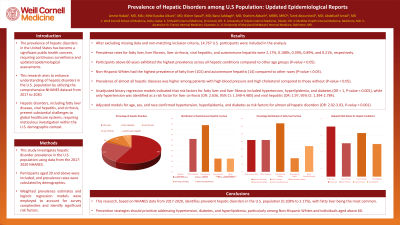Tuesday Poster Session
Category: Liver
P4583 - Prevalence of Hepatic Disorders Among U.S Population: Updated Epidemiological Reports
Tuesday, October 29, 2024
10:30 AM - 4:00 PM ET
Location: Exhibit Hall E

Has Audio

Amine Rakab, MD, MSc
Weill Cornell Medicine
Doha, Ad Dawhah, Qatar
Presenting Author(s)
Mhd Kutaiba Albuni, MD1, Bisher Sawaf, MD2, Bana Sabbagh, MD3, Shahem Abbarah, MD4, Tarek Aboursheid, MD5, Abdellatif Ismail, MD6, Amine Rakab, MD, MSc7
1TriHealth, Doha, Ad Dawhah, Qatar; 2University of Toledo, Toledo, OH; 3TriHealth, Cincinnati, OH; 4MedStar Health, Baltimore, MD; 5Ascension Saint Francis Hospital, Evanston, IL; 6University of Maryland Medical Center, Baltimore, MD; 7Weill Cornell Medicine, Doha, Ad Dawhah, Qatar
Introduction: The high occurrence of liver diseases in the United States is a major public health issue. This study aims to examine the prevalence of liver disorders in the U.S. population, such as fatty liver disease, viral hepatitis, and cirrhosis, to understand the specific demographic context of the United States.
Methods: This study utilized data from the National Health and Nutrition Examination Survey (NHANES) from 2017 to 2020. The participants included individuals aged 20 and above. The study conducted weighted prevalence estimates and logistic regression models to identify significant risk factors and differences in the prevalence of hepatic disorders among different sociodemographic groups.
Results: After excluding missing data and non-matching inclusion criteria, 14,767 U.S. Participants were included in the analysis. Prevalence rates for fatty liver, liver fibrosis, liver cirrhosis, viral hepatitis, and autoimmune hepatitis were 2.17%, 0.108%, 0.39%, 0.89%, and 0.21%, respectively. Participants above 60 years old exhibited the highest prevalence across all hepatic conditions compared to other age groups (P-value < 0.05). Non-Hispanic Whites had the highest prevalence of fatty liver (101) and autoimmune hepatitis (14) compared to other races (P-value < 0.05). The prevalence of almost all hepatic diseases was higher among patients with high blood pressure and high cholesterol compared to those without (P-value < 0.05). Unadjusted binary regression models indicated that risk factors for fatty liver and liver fibrosis included high blood pressure, high cholesterol, and diabetes mellitus (OR at; 1, P-value at; 0.001). In contrast, only high blood pressure was identified as a risk factor for liver cirrhosis (OR: 2.636, 95% CI: 1.549-4.485) and viral hepatitis (OR: 1.97, 95% CI: 1.394-2.784). Adjusted models for age, sex, and race confirmed high blood pressure, high cholesterol, and diabetes mellitus as risk factors for almost all hepatic disorders (OR: 2.02-3.03, P-value at; 0.001).
Discussion: Based on NHANES data from 2017-2020, this research identifies prevalent hepatic
disorders in the U.S. population (0.108% to 2.17%), with fatty liver being the most
common. It is important for prevention strategies to prioritize addressing high-blood
pressure, diabetes, and high cholesterol, particularly among non-Hispanic whites and
individuals aged above 60.
Disclosures:
Mhd Kutaiba Albuni, MD1, Bisher Sawaf, MD2, Bana Sabbagh, MD3, Shahem Abbarah, MD4, Tarek Aboursheid, MD5, Abdellatif Ismail, MD6, Amine Rakab, MD, MSc7. P4583 - Prevalence of Hepatic Disorders Among U.S Population: Updated Epidemiological Reports, ACG 2024 Annual Scientific Meeting Abstracts. Philadelphia, PA: American College of Gastroenterology.
1TriHealth, Doha, Ad Dawhah, Qatar; 2University of Toledo, Toledo, OH; 3TriHealth, Cincinnati, OH; 4MedStar Health, Baltimore, MD; 5Ascension Saint Francis Hospital, Evanston, IL; 6University of Maryland Medical Center, Baltimore, MD; 7Weill Cornell Medicine, Doha, Ad Dawhah, Qatar
Introduction: The high occurrence of liver diseases in the United States is a major public health issue. This study aims to examine the prevalence of liver disorders in the U.S. population, such as fatty liver disease, viral hepatitis, and cirrhosis, to understand the specific demographic context of the United States.
Methods: This study utilized data from the National Health and Nutrition Examination Survey (NHANES) from 2017 to 2020. The participants included individuals aged 20 and above. The study conducted weighted prevalence estimates and logistic regression models to identify significant risk factors and differences in the prevalence of hepatic disorders among different sociodemographic groups.
Results: After excluding missing data and non-matching inclusion criteria, 14,767 U.S. Participants were included in the analysis. Prevalence rates for fatty liver, liver fibrosis, liver cirrhosis, viral hepatitis, and autoimmune hepatitis were 2.17%, 0.108%, 0.39%, 0.89%, and 0.21%, respectively. Participants above 60 years old exhibited the highest prevalence across all hepatic conditions compared to other age groups (P-value < 0.05). Non-Hispanic Whites had the highest prevalence of fatty liver (101) and autoimmune hepatitis (14) compared to other races (P-value < 0.05). The prevalence of almost all hepatic diseases was higher among patients with high blood pressure and high cholesterol compared to those without (P-value < 0.05). Unadjusted binary regression models indicated that risk factors for fatty liver and liver fibrosis included high blood pressure, high cholesterol, and diabetes mellitus (OR at; 1, P-value at; 0.001). In contrast, only high blood pressure was identified as a risk factor for liver cirrhosis (OR: 2.636, 95% CI: 1.549-4.485) and viral hepatitis (OR: 1.97, 95% CI: 1.394-2.784). Adjusted models for age, sex, and race confirmed high blood pressure, high cholesterol, and diabetes mellitus as risk factors for almost all hepatic disorders (OR: 2.02-3.03, P-value at; 0.001).
Discussion: Based on NHANES data from 2017-2020, this research identifies prevalent hepatic
disorders in the U.S. population (0.108% to 2.17%), with fatty liver being the most
common. It is important for prevention strategies to prioritize addressing high-blood
pressure, diabetes, and high cholesterol, particularly among non-Hispanic whites and
individuals aged above 60.
Disclosures:
Mhd Kutaiba Albuni indicated no relevant financial relationships.
Bisher Sawaf indicated no relevant financial relationships.
Bana Sabbagh indicated no relevant financial relationships.
Shahem Abbarah indicated no relevant financial relationships.
Tarek Aboursheid indicated no relevant financial relationships.
Abdellatif Ismail indicated no relevant financial relationships.
Amine Rakab indicated no relevant financial relationships.
Mhd Kutaiba Albuni, MD1, Bisher Sawaf, MD2, Bana Sabbagh, MD3, Shahem Abbarah, MD4, Tarek Aboursheid, MD5, Abdellatif Ismail, MD6, Amine Rakab, MD, MSc7. P4583 - Prevalence of Hepatic Disorders Among U.S Population: Updated Epidemiological Reports, ACG 2024 Annual Scientific Meeting Abstracts. Philadelphia, PA: American College of Gastroenterology.

